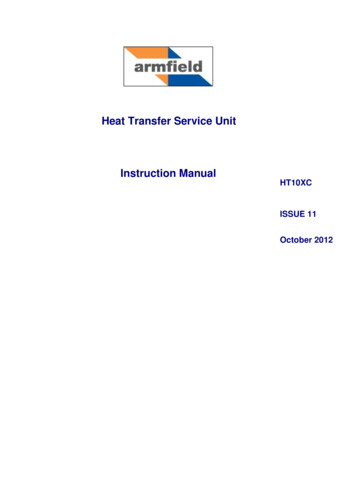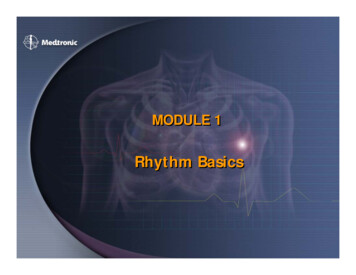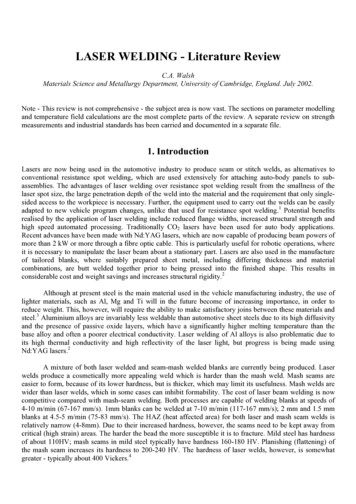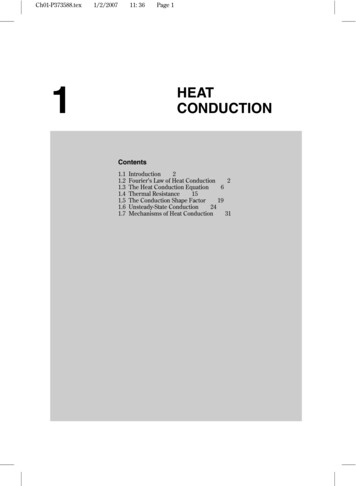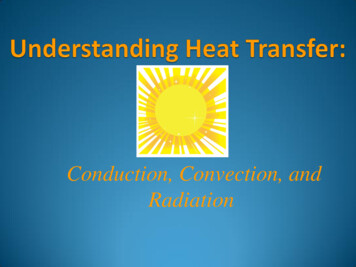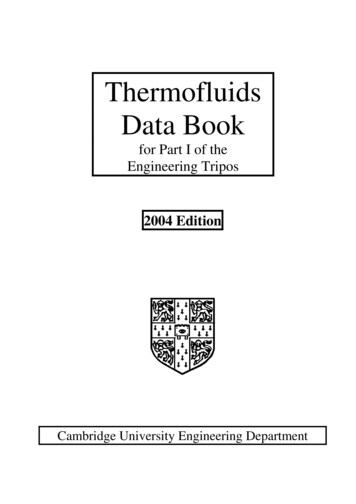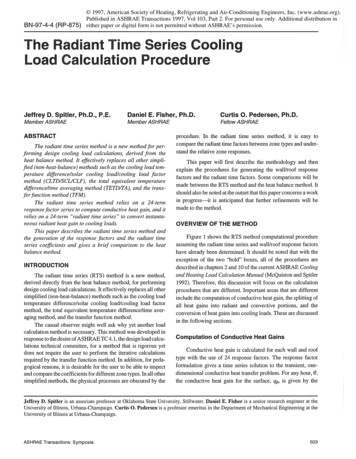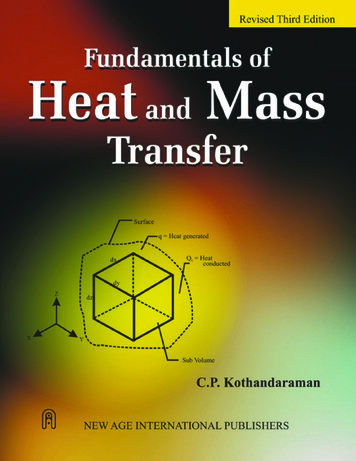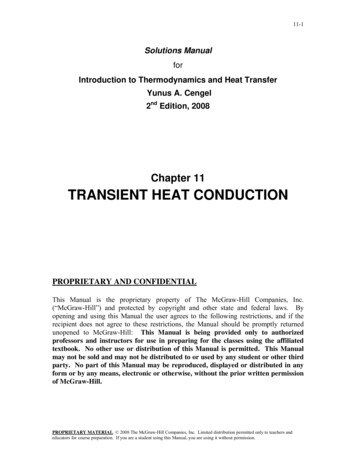
Transcription
11-1Solutions ManualforIntroduction to Thermodynamics and Heat TransferYunus A. Cengel2nd Edition, 2008Chapter 11TRANSIENT HEAT CONDUCTIONPROPRIETARY AND CONFIDENTIALThis Manual is the proprietary property of The McGraw-Hill Companies, Inc.(“McGraw-Hill”) and protected by copyright and other state and federal laws. Byopening and using this Manual the user agrees to the following restrictions, and if therecipient does not agree to these restrictions, the Manual should be promptly returnedunopened to McGraw-Hill: This Manual is being provided only to authorizedprofessors and instructors for use in preparing for the classes using the affiliatedtextbook. No other use or distribution of this Manual is permitted. This Manualmay not be sold and may not be distributed to or used by any student or other thirdparty. No part of this Manual may be reproduced, displayed or distributed in anyform or by any means, electronic or otherwise, without the prior written permissionof McGraw-Hill.PROPRIETARY MATERIAL. 2008 The McGraw-Hill Companies, Inc. Limited distribution permitted only to teachers andeducators for course preparation. If you are a student using this Manual, you are using it without permission.
11-2Lumped System Analysis11-1C In heat transfer analysis, some bodies are observed to behave like a "lump" whose entire bodytemperature remains essentially uniform at all times during a heat transfer process. The temperature of suchbodies can be taken to be a function of time only. Heat transfer analysis which utilizes this idealization isknown as the lumped system analysis. It is applicable when the Biot number (the ratio of conductionresistance within the body to convection resistance at the surface of the body) is less than or equal to 0.1.11-2C The lumped system analysis is more likely to be applicable for the body cooled naturally since theBiot number is proportional to the convection heat transfer coefficient, which is proportional to the airvelocity. Therefore, the Biot number is more likely to be less than 0.1 for the case of natural convection.11-3C The lumped system analysis is more likely to be applicable for the body allowed to cool in the airsince the Biot number is proportional to the convection heat transfer coefficient, which is larger in waterthan it is in air because of the larger thermal conductivity of water. Therefore, the Biot number is morelikely to be less than 0.1 for the case of the solid cooled in the air11-4C The temperature drop of the potato during the second minute will be less than 4 C since thetemperature of a body approaches the temperature of the surrounding medium asymptotically, and thus itchanges rapidly at the beginning, but slowly later on.11-5C The temperature rise of the potato during the second minute will be less than 5 C since thetemperature of a body approaches the temperature of the surrounding medium asymptotically, and thus itchanges rapidly at the beginning, but slowly later on.11-6C Biot number represents the ratio of conduction resistance within the body to convection resistance atthe surface of the body. The Biot number is more likely to be larger for poorly conducting solids since suchbodies have larger resistances against heat conduction.11-7C The heat transfer is proportional to the surface area. Two half pieces of the roast have a much largersurface area than the single piece and thus a higher rate of heat transfer. As a result, the two half pieces willcook much faster than the single large piece.11-8C The cylinder will cool faster than the sphere since heat transfer rate is proportional to the surfacearea, and the sphere has the smallest area for a given volume.11-9C The lumped system analysis is more likely to be applicable in air than in water since the convectionheat transfer coefficient and thus the Biot number is much smaller in air.11-10C The lumped system analysis is more likely to be applicable for a golden apple than for an actualapple since the thermal conductivity is much larger and thus the Biot number is much smaller for gold.11-11C The lumped system analysis is more likely to be applicable to slender bodies than the well-roundedbodies since the characteristic length (ratio of volume to surface area) and thus the Biot number is muchsmaller for slender bodies.PROPRIETARY MATERIAL. 2008 The McGraw-Hill Companies, Inc. Limited distribution permitted only to teachers andeducators for course preparation. If you are a student using this Manual, you are using it without permission.
11-311-12 Relations are to be obtained for the characteristic lengths of a large plane wall of thickness 2L, avery long cylinder of radius ro and a sphere of radius ro.Analysis Relations for the characteristiclengths of a large plane wall of thickness 2L, avery long cylinder of radius ro and a sphere ofradius ro areLc , wall Lc ,cylinder Lc , sphere VAsurfaceVAsurfaceVAsurface 2 LA L2A πro2 h ro 2πro h 2 4πro3 / 34πro 2 ro32ro2ro2L11-13 A relation for the time period for a lumped system to reach the average temperature (Ti T ) / 2 isto be obtained.Analysis The relation for time period for a lumped system to reach the average temperature (Ti T ) / 2can be determined asT (t ) T e bt Ti T Ti T T 2 e btTi T Ti T 1 e bt e bt2(Ti T )2 bt ln 2 t T Tiln 2 0.693 bbPROPRIETARY MATERIAL. 2008 The McGraw-Hill Companies, Inc. Limited distribution permitted only to teachers andeducators for course preparation. If you are a student using this Manual, you are using it without permission.
11-411-14 The temperature of a gas stream is to be measured by a thermocouple. The time it takes to register 99percent of the initial ΔT is to be determined.Assumptions 1 The junction is spherical in shape with a diameter of D 0.0012 m. 2 The thermalproperties of the junction are constant. 3 The heat transfer coefficient is constant and uniform over theentire surface. 4 Radiation effects are negligible. 5 The Biot number is Bi 0.1 so that the lumped systemanalysis is applicable (this assumption will be verified).Properties The properties of the junction are given to be k 35 W/m. C , ρ 8500 kg/m 3 , andc p 320 J/kg. C .Analysis The characteristic length of the junction and the Biot number areLc Bi VAsurface πD 3 / 6 D 0.0012 m 0.0002 m66πD 2hLc (90 W/m 2 . C)(0.0002 m) 0.00051 0.1k(35 W/m. C)Since Bi 0.1 , the lumped system analysis is applicable.Then the time period for the thermocouple to read 99% of theinitial temperature difference is determined fromGash, T T (t ) T 0.01Ti T b JunctionDT(t)hAh90 W/m 2 . C 0.1654 s -1ρc pV ρc p Lc (8500 kg/m 3 )(320 J/kg. C)(0.0002 m)-1T (t ) T e bt 0.01 e ( 0.1654 s )t t 27.8 sTi T PROPRIETARY MATERIAL. 2008 The McGraw-Hill Companies, Inc. Limited distribution permitted only to teachers andeducators for course preparation. If you are a student using this Manual, you are using it without permission.
11-511-15E A number of brass balls are to be quenched in a water bath at a specified rate. The temperature ofthe balls after quenching and the rate at which heat needs to be removed from the water in order to keep itstemperature constant are to be determined.Assumptions 1 The balls are spherical in shape with a radius of ro 1 in. 2 The thermal properties of theballs are constant. 3 The heat transfer coefficient is constant and uniform over the entire surface. 4 TheBiot number is Bi 0.1 so that the lumped system analysis is applicable (this assumption will be verified).Properties The thermal conductivity, density, and specific heat of the brass balls are given to be k 64.1Btu/h.ft. F, ρ 532 lbm/ft3, and cp 0.092 Btu/lbm. F.Analysis (a) The characteristic length and theBiot number for the brass balls areLc Bi VAs Brass balls, 250 FπD 3 / 6 D 2 / 12 ft 0.02778 ft66πD 2Water bath, 120 FhLc (42 Btu/h.ft 2 . F)(0.02778 ft ) 0.01820 0.1k(64.1 Btu/h.ft. F)The lumped system analysis is applicable since Bi 0.1. Then the temperature of the balls after quenchingbecomesb hAsh42 Btu/h.ft 2 . F 30.9 h -1 0.00858 s -13ρc pV ρc p Lc (532 lbm/ft )(0.092 Btu/lbm. F)(0.02778 ft)-1T (t ) T T (t ) 120 e bt e (0.00858 s )(120 s) T (t ) 166 FTi T 250 120(b) The total amount of heat transfer from a ball during a 2-minute period ism ρV ρπD 3 (532 lbm/ft 3 )π (2 / 12 ft) 3 1.290 lbm66Q mc p [Ti T (t )] (1.29 lbm)(0.092 Btu/lbm. F)(250 166) F 9.97 BtuThen the rate of heat transfer from the balls to the water becomesQ& total n& ball Q ball (120 balls/min) (9.97 Btu ) 1196 Btu/minTherefore, heat must be removed from the water at a rate of 1196 Btu/min in order to keep its temperatureconstant at 120 F.PROPRIETARY MATERIAL. 2008 The McGraw-Hill Companies, Inc. Limited distribution permitted only to teachers andeducators for course preparation. If you are a student using this Manual, you are using it without permission.
11-611-16E A number of aluminum balls are to be quenched in a water bath at a specified rate. The temperatureof balls after quenching and the rate at which heat needs to be removed from the water in order to keep itstemperature constant are to be determined.Assumptions 1 The balls are spherical in shape with a radius of ro 1 in. 2 The thermal properties of theballs are constant. 3 The heat transfer coefficient is constant and uniform over the entire surface. 4 TheBiot number is Bi 0.1 so that the lumped system analysis is applicable (this assumption will be verified).Properties The thermal conductivity, density, and specific heat of the aluminum balls are k 137Btu/h.ft. F, ρ 168 lbm/ft3, and cp 0.216 Btu/lbm. F (Table A-24E).Analysis (a) The characteristic length and theBiot number for the aluminum balls areLc Bi VA πD 3 / 6 D 2 / 12 ft 0.02778 ft66πD 2Aluminum balls,250 FWater bath, 120 FhLc (42 Btu/h.ft 2 . F)(0.02778 ft ) 0.00852 0.1(137 Btu/h.ft. F)kThe lumped system analysis is applicable since Bi 0.1. Then the temperature of the balls after quenchingbecomesb hAs42 Btu/h.ft 2 . Fh 41.66 h -1 0.01157 s -13ρc pV ρc p Lc (168 lbm/ft )(0.216 Btu/lbm. F)(0.02778 ft)-1T (t ) T T (t ) 120 e bt e ( 0.01157 s )(120 s) T (t ) 152 F250 120Ti T (b) The total amount of heat transfer from a ball during a 2-minute period ism ρV ρπD 3 (168 lbm/ft 3 )π (2 / 12 ft) 3 0.4072 lbm66Q mc p [Ti T (t )] (0.4072 lbm)(0.216 Btu/lbm. F)(250 152) F 8.62 BtuThen the rate of heat transfer from the balls to the water becomesQ& total n& ball Q ball (120 balls/min) (8.62 Btu ) 1034 Btu/minTherefore, heat must be removed from the water at a rate of 1034 Btu/min in order to keep its temperatureconstant at 120 F.PROPRIETARY MATERIAL. 2008 The McGraw-Hill Companies, Inc. Limited distribution permitted only to teachers andeducators for course preparation. If you are a student using this Manual, you are using it without permission.
11-711-17 Milk in a thin-walled glass container is to be warmed up by placing it into a large pan filled with hotwater. The warming time of the milk is to be determined.Assumptions 1 The glass container is cylindrical in shape with aradius of r0 3 cm. 2 The thermal properties of the milk are takento be the same as those of water. 3 Thermal properties of the milkare constant at room temperature. 4 The heat transfer coefficient isconstant and uniform over the entire surface. 5 The Biot number inthis case is large (much larger than 0.1). However, the lumpedsystem analysis is still applicable since the milk is stirredconstantly, so that its temperature remains uniform at all times.Water60 CMilk3 CProperties The thermal conductivity, density, and specific heat ofthe milk at 20 C are k 0.598 W/m. C, ρ 998 kg/m3, and cp 4.182 kJ/kg. C (Table A-15).Analysis The characteristic length and Biot number for the glass of milk areLc Bi VAs πro2 L2πro L 2πro2 π (0.03 m) 2 (0.07 m) 0.01050 m2π (0.03 m)(0.07 m) 2π (0.03 m) 2hLc (120 W/m 2 . C)(0.0105 m) 2.107 0.1k(0.598 W/m. C)For the reason explained above we can use the lumped system analysis to determine how long it will takefor the milk to warm up to 38 C:b hAs120 W/m 2 . Ch 0.002738 s -1ρc pV ρc p Lc (998 kg/m 3 )(4182 J/kg. C)(0.0105 m)-1T (t ) T 38 60 e bt e ( 0.002738 s )t t 348 s 5.8 minTi T 3 60Therefore, it will take about 6 minutes to warm the milk from 3 to 38 C.PROPRIETARY MATERIAL. 2008 The McGraw-Hill Companies, Inc. Limited distribution permitted only to teachers andeducators for course preparation. If you are a student using this Manual, you are using it without permission.
11-811-18 A thin-walled glass containing milk is placed into a large pan filled with hot water to warm up themilk. The warming time of the milk is to be determined.Assumptions 1 The glass container is cylindrical in shape with aradius of r0 3 cm. 2 The thermal properties of the milk are takenWaterto be the same as those of water. 3 Thermal properties of the milk60 Care constant at room temperature. 4 The heat transfer coefficient isconstant and uniform over the entire surface. 5 The Biot number inthis case is large (much larger than 0.1). However, the lumpedMilksystem analysis is still applicable since the milk is stirred3 Cconstantly, so that its temperature remains uniform at all times.Properties The thermal conductivity, density, and specific heat ofthe milk at 20 C are k 0.598 W/m. C, ρ 998 kg/m3, and cp 4.182 kJ/kg. C (Table A-15).Analysis The characteristic length and Biot number for the glass of milk areLc Bi VAs πro2 L2πro L 2πro2 π (0.03 m) 2 (0.07 m) 0.01050 m2π (0.03 m)(0.07 m) 2π (0.03 m) 2hLc (240 W/m 2 . C)(0.0105 m) 4.21 0.1(0.598 W/m. C)kFor the reason explained above we can use the lumped system analysis to determine how long it will takefor the milk to warm up to 38 C:hAs240 W/m 2 . Ch 0.005477 s -1ρc pV ρc p Lc (998 kg/m 3 )(4182 J/kg. C)(0.0105 m)b -1T (t ) T 38 60 e bt e (0.005477 s )t t 174 s 2.9 min3 60Ti T Therefore, it will take about 3 minutes to warm the milk from 3 to 38 C.11-19 A long copper rod is cooled to a specified temperature. The cooling time is to be determined.Assumptions 1 The thermal properties of the geometry are constant. 2 The heat transfer coefficient isconstant and uniform over the entire surface.Properties The properties of copper are k 401 W/m ºC, ρ 8933 kg/m3, and cp 0.385 kJ/kg ºC (TableA-24).Analysis For cylinder, the characteristic length and the Biot number areLc VAsurface (πD 2 / 4) L D 0.02 m 0.005 m44πDLhL(200 W/m 2 . C)(0.005 m)Bi c 0.0025 0.1k(401 W/m. C)D 2 cmTi 100 ºCSince Bi 0.1 , the lumped system analysis is applicable. Then the cooling time is determined fromb hAh200 W/m 2 . C 0.01163 s -1ρc pV ρc p Lc (8933 kg/m 3 )(385 J/kg. C)(0.005 m)-1T (t ) T 25 20 e bt e ( 0.01163 s )t t 238 s 4.0 minTi T 100 20PROPRIETARY MATERIAL. 2008 The McGraw-Hill Companies, Inc. Limited distribution permitted only to teachers andeducators for course preparation. If you are a student using this Manual, you are using it without permission.
11-911-20 The heating times of a sphere, a cube, and a rectangular prism with similar dimensions are to bedetermined.Assumptions 1 The thermal properties of the geometries are constant. 2 The heat transfer coefficient isconstant and uniform over the entire surface.Properties The properties of silver are given to be k 429 W/m ºC, ρ 10,500 kg/m3, and cp 0.235kJ/kg ºC.Analysis For sphere, the characteristic length and the Biot number areLc Bi V AsurfaceπD 3 / 6 D 0.05 m 0.008333 m66πD 25 cmhLc (12 W/m 2 . C)(0.008333 m) 0.00023 0.1k(429 W/m. C)Airh, T Since Bi 0.1 , the lumped system analysis is applicable. Then the time period for the sphere temperatureto reach to 25ºC is determined fromb hAh12 W/m 2 . C 0.0005836 s -13ρc pV ρc p Lc (10,500 kg/m )(235 J/kg. C)(0.008333 m)-1T (t ) T 25 33 e bt e ( 0.0005836 s )t t 2428 s 40.5 minTi T 0 33Cube:Lc Bi b VAsurfaceL3L 0.05 m 2 0.008333 m666L2hLc (12 W/m . C)(0.008333 m) 0.00023 0.1k(429 W/m. C)5 cm5 cmAirh, T 5 cmhAh12 W/m 2 . C 0.0005836 s -1ρc pV ρc p Lc (10,500 kg/m 3 )(235 J/kg. C)(0.008333 m)-1T (t ) T 25 33 e bt e ( 0.0005836 s )t t 2428 s 40.5 minTi T 0 33Rectangular prism:Lc Bi b VAsurface (0.04 m)(0.05 m)(0.06 m) 0.008108 m2(0.04 m)(0.05 m) 2(0.04 m)(0.06 m) 2(0.05 m)(0.06 m)hLc (12 W/m 2 . C)(0.008108 m) 0.00023 0.1k(429 W/m. C)4 cmhAh ρc pV ρc p Lc12 W/m 2 . C(10,500 kg/m 3 )(235 J/kg. C)(0.008108 m)5 cm 0.0005998 s -1Airh, T 6 cm-1T (t ) T 25 33 e bt e ( 0.0005998 s )t t 2363 s 39.4 minTi T 0 33The heating times are same for the sphere and cube while it is smaller in rectangular prism.PROPRIETARY MATERIAL. 2008 The McGraw-Hill Companies, Inc. Limited distribution permitted only to teachers andeducators for course preparation. If you are a student using this Manual, you are using it without permission.
11-1011-21E A person shakes a can of drink in a iced water to cool it. The cooling time of the drink is to bedetermined.Assumptions 1 The can containing the drink is cylindrical in shapewith a radius of ro 1.25 in. 2 The thermal properties of the drinkare taken to be the same as those of water. 3 Thermal properties ofthe drinkare constant at room temperature. 4 The heat transfercoefficient is constant and uniform over the entire surface. 5 TheBiot number in this case is large (much larger than 0.1). However,the lumped system analysis is still applicable since the drink isstirred constantly, so that its temperature remains uniform at alltimes.Water32 FDrinkMilk3 C90 FProperties The density and specific heat of water at roomtemperature are ρ 62.22 lbm/ft3, and cp 0.999 Btu/lbm. F(Table A-15E).Analysis Application of lumped system analysis in this case givesLc b VAs πro2 L2πro L 2πro 2 π (1.25 / 12 ft) 2 (5 / 12 ft) 0.04167 ft2π (1.25 / 12 ft)(5/12 ft) 2π (1.25 / 12 ft) 2hAs30 Btu/h.ft 2 . Fh 11.583 h -1 0.00322 s -1ρc pV ρc p Lc (62.22 lbm/ft 3 )(0.999 Btu/lbm. F)(0.04167 ft)-1T (t ) T 40 32 e ( 0.00322 s )t t 615 s e bt 90 32Ti T Therefore, it will take 10 minutes and 15 seconds to cool the canned drink to 40 F.PROPRIETARY MATERIAL. 2008 The McGraw-Hill Companies, Inc. Limited distribution permitted only to teachers andeducators for course preparation. If you are a student using this Manual, you are using it without permission.
11-1111-22 An iron whose base plate is made of an aluminum alloy is turned on. The time for the platetemperature to reach 140 C and whether it is realistic to assume the plate temperature to be uniform at alltimes are to be determined.Assumptions 1 85 percent of the heat generated in the resistance wires is transferred to the plate. 2 Thethermal properties of the plate are constant. 3 The heat transfer coefficient is constant and uniform over theentire surface.Properties The density, specific heat, and thermal diffusivity of the aluminum alloy plate are given to be ρ 2770 kg/m3, cp 875 kJ/kg. C, and α 7.3 10-5 m2/s. The thermal conductivity of the plate can bedetermined from k αρcp 177 W/m. C (or it can be read from Table A-24).Analysis The mass of the iron's base plate is3Air22 C2m ρV ρLA (2770 kg/m )(0.005 m)(0.03 m ) 0.4155 kgNoting that only 85 percent of the heat generated is transferred to theplate, the rate of heat transfer to the iron's base plate isQ& 0.85 1000 W 850 WIRON1000 WinThe temperature of the plate, and thus the rate of heat transfer from theplate, changes during the process. Using the average plate temperature,the average rate of heat loss from the plate is determined from 140 22 Q& loss hA(Tplate, ave T ) (12 W/m 2 . C)(0.03 m 2 ) 22 C 21.2 W2 Energy balance on the plate can be expressed asE in E out ΔE plate Q& in Δt Q& out Δt ΔE plate mc p ΔTplateSolving for Δt and substituting,Δt mc p ΔTplate (0.4155 kg )(875 J/kg. C)(140 22) C 51.8 s(850 21.2) J/sQ& Q&inoutwhich is the time required for the plate temperature to reach 140 C . To determine whether it is realistic toassume the plate temperature to be uniform at all times, we need to calculate the Biot number,Lc Bi VAs LA L 0.005 mAhLc (12 W/m 2 . C)(0.005 m) 0.00034 0.1(177.0 W/m. C)kIt is realistic to assume uniform temperature for the plate since Bi 0.1.Discussion This problem can also be solved by obtaining the differential equation from an energy balanceon the plate for a differential time interval, and solving the differential equation. It givesT (t ) T Q& inhA 1 exp( hA t ) mc p Substituting the known quantities and solving for t again gives 51.8 s.PROPRIETARY MATERIAL. 2008 The McGraw-Hill Companies, Inc. Limited distribution permitted only to teachers andeducators for course preparation. If you are a student using this Manual, you are using it without permission.
11-1211-23 EES Prob. 11-22 is reconsidered. The effects of the heat transfer coefficient and the final platetemperature on the time it will take for the plate to reach this temperature are to be investigated.Analysis The problem is solved using EES, and the solution is given below."GIVEN"E dot 1000 [W]L 0.005 [m]A 0.03 [m 2]T infinity 22 [C]T i T infinityh 12 [W/m 2-C]f heat 0.85T f 140 [C]"PROPERTIES"rho 2770 [kg/m 3]c p 875 [J/kg-C]alpha 7.3E-5 [m 2/s]"ANALYSIS"V L*Am rho*VQ dot in f heat*E dotQ dot out h*A*(T ave-T infinity)T ave 1/2*(T i T f)(Q dot in-Q dot out)*time m*c p*(T f-T i) "energy balance on the plate"time 3.2453.2552.852.35tim e [s]h [W/m2.C]579111315171921232551.951.4551591321721h [W /m -C]PROPRIETARY MATERIAL. 2008 The McGraw-Hill Companies, Inc. Limited distribution permitted only to teachers andeducators for course preparation. If you are a student using this Manual, you are using it without permission.25
11-13time im e [s]Tf 40302010020406080100120140160180200T f [C]PROPRIETARY MATERIAL. 2008 The McGraw-Hill Companies, Inc. Limited distribution permitted only to teachers andeducators for course preparation. If you are a student using this Manual, you are using it without permission.
11-1411-24 Ball bearings leaving the oven at a uniform temperature of 900 C are exposed to air for a whilebefore they are dropped into the water for quenching. The time they can stand in the air before theirtemperature falls below 850 C is to be determined.Assumptions 1 The bearings are spherical in shape with a radius of ro 0.6 cm. 2 The thermal properties ofthe bearings are constant. 3 The heat transfer coefficient is constant and uniform over the entire surface. 4The Biot number is Bi 0.1 so that the lumped system analysis is applicable (this assumption will beverified).Properties The thermal conductivity, density, and specific heat of the bearings are given to be k 15.1W/m. C, ρ 8085 kg/m3, and cp 0.480 kJ/kg. F.Analysis The characteristic length of the steel ball bearings and Biot number areLc VAs πD 3 / 6 D 0.012 m 0.002 m66πD 2Furnace2hL(125 W/m . C)(0.002 m) 0.0166 0.1Bi c (15.1 W/m. C)kSteel balls900 CAir, 30 CTherefore, the lumped system analysis is applicable.Then the allowable time is determined to beb hAs125 W/m 2 . Ch 0.01610 s -13ρc pV ρc p Lc (8085 kg/m )(480 J/kg. C)(0.002 m)-1T (t ) T 850 30 e bt e ( 0.0161 s )t t 3.68 s900 30Ti T The result indicates that the ball bearing can stay in the air about 4 s before being dropped into the water.PROPRIETARY MATERIAL. 2008 The McGraw-Hill Companies, Inc. Limited distribution permitted only to teachers andeducators for course preparation. If you are a student using this Manual, you are using it without permission.
11-1511-25 A number of carbon steel balls are to be annealed by heating them first and then allowing them tocool slowly in ambient air at a specified rate. The time of annealing and the total rate of heat transfer fromthe balls to the ambient air are to be determined.Assumptions 1 The balls are spherical in shape with a radius of ro 4 mm. 2 The thermal properties of theballs are constant. 3 The heat transfer coefficient is constant and uniform over the entire surface. 4 TheBiot number is Bi 0.1 so that the lumped system analysis is applicable (this assumption will be verified).Properties The thermal conductivity, density, and specific heat of the balls are given to be k 54 W/m. C,ρ 7833 kg/m3, and cp 0.465 kJ/kg. C.Analysis The characteristic length of the balls and the Biot number areLc Bi VAs πD 3 / 6 D 0.008 m 0.0013 m66πD 2Furnace2hLc (75 W/m . C)(0.0013 m) 0.0018 0.1 (54 W/m. C)kSteel balls900 CAir, 35 CTherefore, the lumped system analysis is applicable.Then the time for the annealing process isdetermined to beb hAs75 W/m 2 . Ch 0.01584 s -1ρc pV ρc p Lc (7833 kg/m 3 )(465 J/kg. C)(0.0013 m)-1T (t ) T 100 35 e bt e (0.01584 s )t t 163 s 2.7 min900 35Ti T The amount of heat transfer from a single ball ism ρV ρπD 3 (7833 kg/m 3 )π (0.008 m) 3 0.0021 kg66Q mc p [T f Ti ] (0.0021 kg)(465 J/kg. C)(900 100) C 781 J 0.781 kJ (per ball)Then the total rate of heat transfer from the balls to the ambient air becomesQ& n& ballQ (2500 balls/h) (0.781 kJ/ball) 1,953 kJ/h 543 WPROPRIETARY MATERIAL. 2008 The McGraw-Hill Companies, Inc. Limited distribution permitted only to teachers andeducators for course preparation. If you are a student using this Manual, you are using it without permission.
11-1611-26 EES Prob. 11-25 is reconsidered. The effect of the initial temperature of the balls on the annealingtime and the total rate of heat transfer is to be investigated.Analysis The problem is solved using EES, and the solution is given below."GIVEN"D 0.008 [m]; T i 900 [C]T f 100 [C]; T infinity 35 [C]h 75 [W/m 2-C]; n dot ball 2500 [1/h]"PROPERTIES"rho 7833 [kg/m 3]; k 54 [W/m-C]c p 465 [J/kg-C]; alpha 1.474E-6 [m 2/s]"ANALYSIS"A pi*D 2V pi*D 3/6L c V/ABi (h*L c)/k "if Bi 0.1, the lumped sytem analysis is applicable"b (h*A)/(rho*c p*V)(T f-T infinity)/(T i-T infinity) exp(-b*time)m rho*VQ m*c p*(T i-T f)Q dot n dot ball*Q*Convert(J/h, W)Ti [C]5005506006507007508008509009501000time 74.7Q 4610.3180650600170550tim e500150450heat400140Q [W ]tim e [s]1603501301205003006007008009002501000T i [C]PROPRIETARY MATERIAL. 2008 The McGraw-Hill Companies, Inc. Limited distribution permitted only to teachers andeducators for course preparation. If you are a student using this Manual, you are using it without permission.
11-1711-27 An electronic device is on for 5 minutes, and off for several hours. The temperature of the device atthe end of the 5-min operating period is to be determined for the cases of operation with and without a heatsink.Assumptions 1 The device and the heat sink are isothermal. 2 The thermal properties of the device and ofthe sink are constant. 3 The heat transfer coefficient is constant and uniform over the entire surface.Properties The specific heat of the device is given to be cp 850 J/kg. C. The specific heat of thealuminum sink is 903 J/kg. C (Table A-24), but can be taken to be 850 J/kg. C for simplicity in analysis.Analysis (a) Approximate solutionThis problem can be solved approximately by using an average temperaturefor the device when evaluating the heat loss. An energy balance on the devicecan be expressed asElectronicdevice20 WE in E out E generation ΔE device Q& out Δt E& generation Δt mc p ΔTdeviceor, T T E& generation Δt hAs T Δt mc p (T T ) 2 Substituting the given values, T 25 o(20 J/s)(5 60 s) (12 W/m 2 . C)(0.0004 m 2 ) C(5 60 s) (0.02 kg )(850 J/kg. C)(T 25) C 2 which givesT 363.6 CIf the device were attached to an aluminum heat sink, the temperature of the device would be T 25 (20 J/s)(5 60 s) (12 W/m 2 . C)(0.0084 m 2 ) C(5 60 s) 2 (0.20 0.02)kg (850 J/kg. C)(T 25) Cwhich givesT 54.7 CNote that the temperature of the electronic device drops considerably as a result of attaching it to a heatsink.(b) Exact solutionThis problem can be solved exactly by obtaining the differential equation from an energy balance on thedevice for a differential time interval dt. We will getE& generationd (T T ) hAs (T T ) dtmc pmc pIt can be solved to giveE& generationT (t ) T hAs 1 exp( hAs t ) mc p Substituting the known quantities and solving for t gives 363.4 C for the first case and 54.6 C for thesecond case, which are practically identical to the results obtained from the approximate analysis.PROPRIETARY MATERIAL. 2008 The McGraw-Hill Companies, Inc. Limited distribution permitted only to teachers andeducators for course preparation. If you are a student using this Manual, you are using it without permission.
11-18Transient Heat Conduction in Large Plane Walls, Long Cylinders, and Spheres with SpatialEffects11-28C A cylinder whose diameter is small relative to its length can be treated as an infinitely longcylinder. When the diameter and length of the cylinder are comparable, it is not proper to treat the cylinderas being infinitely long. It is also not proper to use this model when finding the temperatures near thebottom or top surfaces of a cylinder since heat transfer at those locations can be two-dimensional.11-29C Yes. A plane wall whose one side is insulated is equivalent to a plane wall that is twice as thickand is exposed to convection from both sides. The midplane in the latt
Heat transfer analysis which utilizes this idealization is known as the lumped system analysis. It is applicable when the Biot number (the ratio of conduction resistance within the body to convection resistance

